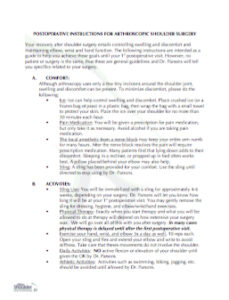Your recovery after shoulder surgery entails controlling swelling and discomfort and maintaining elbow, wrist and hand function. The following instructions are intended as a guide to help you achieve these goals until your 1st postoperative visit. However, no patient or surgery is the same, thus these are general guidelines and Dr. Parsons will tell you specifics related to your surgery.
Postoperative Instructions for Arthroscopic Shoulder Surgery
- 1COMFORT
Although arthroscopy uses only a few tiny incisions around the shoulder joint, swelling and discomfort can be present. To minimize discomfort, please do the following:
- Ice: Ice can help control swelling and discomfort. Place crushed ice (or a frozen bag of peas) in a plastic bag, then wrap the bag with a small towel to protect your skin. Place the ice over your shoulder for no more than 30 minutes each hour.
- Pain Medication: You will be given a prescription for pain medication, but only take it as necessary. Avoid alcohol if you are taking pain medication.
- The local anesthetic from a nerve block may keep your entire arm numb for many hours. After the nerve block resolves the pain will require prescription medication. Many patients find that lying down adds to their discomfort. Sleeping in a recliner, or propped up in bed often works best. A pillow placed behind your elbow may also help.
- Sling: A sling has been provided for your comfort. Use the sling until directed to stop using by Dr. Parsons.
- 2ACTIVITIES
- Sling Use: You will be immobilized with a sling for approximately 4-6 weeks, depending on your surgery. Dr. Parsons will let you know how long it will be at your 1st postoperative visit. You may gently remove the sling for dressing, hygiene, and elbow/wrist/hand exercises.
- Physical Therapy: Exactly when you start therapy and what you will be allowed to do at therapy will depend on how extensive your surgery was. We will go over all of this with you after surgery. In many cases physical therapy is delayed until after the first postoperative visit.
- Exercise your hand, wrist, and elbow 3x a day as well, 10 reps each. Open your sling and flex and extend your elbow and wrist to avoid stiffness. Take care that theses movements do not involve the shoulder.
- Daily Activities: NO active flexion or elevation of your shoulder until given the OK by Dr. Parsons
- Athletic Activities: Activities such as swimming, biking, jogging, etc. should be avoided until allowed by Dr. Parsons.
- 3WOUND CARE
- You may shower with the bandage on. Attempt to keep the area of surgery away from the shower, however
- Remove your dressing 3 days after surgery. No additional dressing is necessary.
- Do not soak in a bathtub, just shower and pat the wounds dry.
- 4DIET
- The first few meals after surgery should be light, easily digestible foods and plenty of liquids, as some people experience slight nausea as a temporary reaction to anesthesia.
- 5CALL YOUR PHYSICIAN IF
- Pain in your shoulder persists or worsens after the first 48-72 hours.
- Excessive redness or drainage of cloudy or bloody material presents around the incisions.
- Your temperature is greater than 101.5˚ more than 48 hrs after surgery.
- You have significant pain or redness in your hand or arm.
- You have numbness or weakness in your arm or hand that persists more than 48 hours following the surgery.
- 6FOLLOW-UP
- In most cases follow-up was already arranged at the time surgery was scheduled. If not, contact the office today or tomorrow to arrange follow-up.

